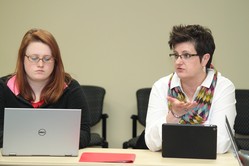During the PC(USA)’s annual Evangelism and Church Growth Conference last summer, Christine Hong—the Presbyterian Mission Agency’s associate for interfaith relations—memorably told participants, “If you’re not learning something every day, you are not doing interfaith relations right.”
And now—in an effort to realize the very goal she articulated—Hong has begun to teach.
If not every day, then at least every week.
In a unique, proactive collaboration this spring with Louisville Presbyterian Theological Seminary’s Doors to Dialogue (D2D) initiative, Hong—assisted by two of her Presbyterian Mission Agency colleagues, Rob Fohr, a mission catalyst, and Sara Otoum, a social media specialist—is teaching a pilot course called “Multifaith Perspectives on Global Displacement.” The course aims to centralize online activism—especially by young adults—around displaced people, and to explore contemporary human displacement, migration, and immigration through an interreligious and intercultural lens.
“It is exciting to be cooperating with Louisville Seminary's D2D program,” says Hong. “The Office of Interfaith Relations and D2D both approach interreligious issues by engaging young adults through education. It's a perfect fit.”
Global displacement, a phenomenon that affects people on a local and global level, is caused by a variety of devastating and potentially polarizing issues: war, natural disaster, lack of resources, economics, incarceration, and even the daily reality of those who say they experience being perpetual foreigners on U.S. soil.
“Religion and faith play a huge role in how people and communities remain resilient through the trauma of displacement,” Hong says. “Religion can also become operationalized in ways that add to the trauma of displaced persons and the communities. Studying and understanding this is crucial to the future ministry of seminarians who will face these issues and narratives in their own neighborhoods.”
For David Madewell, a first-year Louisville Seminary Master of Divinity student who registered for Hong’s class, interfaith dialogue is critical in addressing global displacement. It is an issue that impacts people of all faith traditions and cultures.
“This class is amazing in that it strengthens our awareness of the continuous divisions in the world, as well as our need to work together to address these concerns,” says Madewell. “Though the solution to these countless issues are not always solved quickly, or ever solved at all, the solution lies within educating ourselves and having a better knowledge of the issues both globally and communally.”
As a platform for sharing their thoughts and learnings around displacement from a religious perspective, the 15 students registered for the course are required to blog and to practice public scholarship. Beginning the week of March 23, Hong and her teaching colleagues will start publishing a selection of the students’ blog posts to the class’s webpage to share with the larger church.

DeEtte Huey, right, a Master of Arts in Marriage and Family Therapy student at Louisville Seminary, shares her thoughts in Christine Hong's "Multifaith Perspectives on Global Displacement" class. To her left is Master of Divinity student Lauren Brague. —Chris Wooton
“Because so much scholarship is now occurring in the public sphere, seminarians and ministers alike are able to share ideas, effect change, learn, and teach without official publication,” Hong says. “It's a powerful medium we must learn to use well.”
And a medium with which young adults are already quite familiar.
“In our efforts to better connect with young adults and to equip a multigenerational church, we have learned that interfaith/multifaith work is of great interest to both young adults and those who are involved in young adult ministry,” says Rob Fohr, mission catalyst for the Presbyterian Mission Agency and Louisville Seminary graduate. “On our young-adult-themed website, WhatsNextWhatsNow, the 'interfaith issues' tab is one of the permanent features that consistently generates the most traffic.”
Among the course requirements is the planning, preparation, and presentation of a media project to a specific community of the students’ choice, such as a young adult education class, a youth group gathering, a mid-council meeting, or among seminary colleagues.
“We are hoping to highlight these projects once the course has ended, not only so that congregations can hear how the experience went for our students, but also so they can access a template for teaching the material in their own contexts,” Hong says. “Part of the beauty of the design of this course is that the students will take an active role in the Presbyterian Mission Agency’s goal of equipping congregations to cultivate relationships with their neighbors of different traditions and religions. It’s an exciting collaboration on so many levels.”

